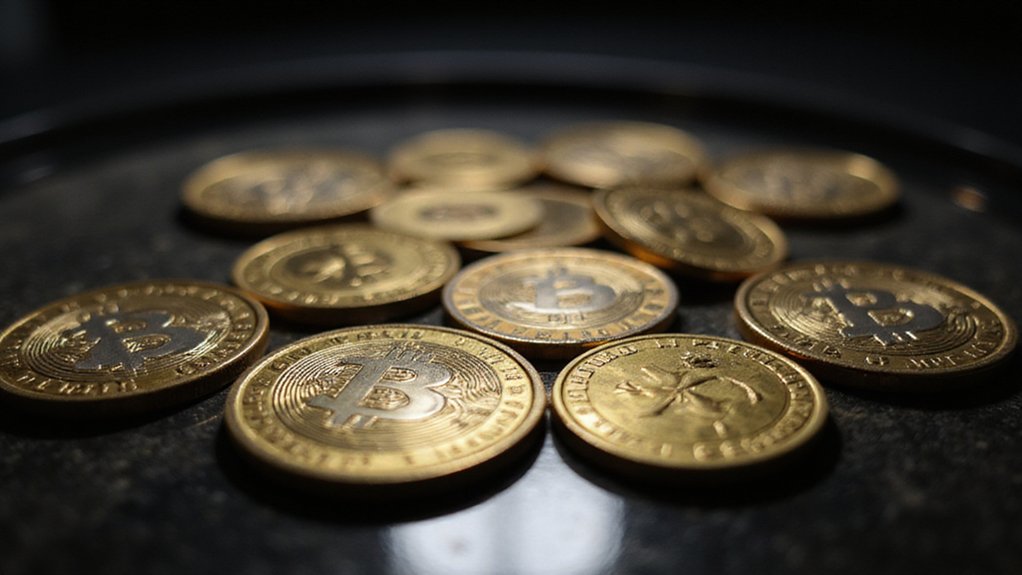Monetary policy operates as cryptocurrency’s invisible puppet master, with expansionary measures boosting digital asset valuations while tightening cycles trigger predictable sell-offs. Central banks—particularly the Federal Reserve—wield disproportionate influence through risk-taking channels that govern investor appetite for volatile assets. Since institutional participation exploded in 2020, cryptocurrencies respond with mathematical precision to interest rate adjustments, contradicting earlier predictions of permanent chaos in unregulated markets. The mechanics underlying these transmission effects reveal surprising complexities.

The relationship between monetary policy and cryptocurrency markets has evolved from a theoretical curiosity into a pressing reality that would have seemed fantastical to central bankers just a decade ago—when digital assets were dismissed as little more than speculative playthings for tech enthusiasts and libertarian ideologues. Today, monetary policy shocks ripple through crypto markets with remarkable consistency, generally depressing prices while paradoxically reducing volatility (a development that surely confounds those who predicted permanent chaos in unregulated digital assets).
Expansionary monetary policy—characterized by the familiar cocktail of low interest rates and quantitative easing—tends to boost cryptocurrency valuations by creating favorable conditions for speculative investment. Conversely, tightening measures including rate hikes predictably constrain crypto price growth or trigger outright depreciation. This relationship operates primarily through what economists diplomatically term the “risk-taking channel,” where loose policy stimulates appetite for volatile assets while restrictive measures prompt investors toward safer harbors.
The Federal Reserve wields disproportionate influence over crypto markets compared to other central banks, a consequence of the dollarization that permeates digital asset trading. Research indicates that a single percentage point increase in US short-term rates produces notable declines in crypto performance relative to traditional equities—a relationship that has intensified dramatically since 2020 as institutional investors entered the space with their characteristic sensitivity to policy shifts.
The Fed’s monetary tightening cascades through crypto markets with surgical precision, humbling assets once celebrated for their defiant independence.
This institutional participation has fundamentally altered market dynamics, making cryptocurrencies more responsive to monetary policy changes than their anarchist origins might suggest. When the Fed tightens, effective risk aversion increases among crypto investors, reducing both their risk appetite and actual holdings. The aggregate crypto factor—which captures broad market movements—contracts during monetary restrictions, demonstrating how thoroughly these supposedly decentralized assets have become entangled with traditional policy mechanisms.
Currently, cryptocurrencies coexist with official currencies without challenging fiat dominance, largely due to their limited scale despite dramatic growth. Bitcoin and Ethereum command approximately 55% of market share, indicating significant concentration within the sector. Whether improved stability algorithms will eventually enable meaningful coexistence with government-issued currencies remains uncertain, though such development would certainly complicate central bank policy transmission in ways policymakers are only beginning to contemplate. The emergence of stablecoin tokens like DAI demonstrates how decentralized protocols can maintain dollar parity through algorithmic monetary policy, potentially offering an alternative model for price stability in digital assets.
Frequently Asked Questions
How Quickly Do Cryptocurrency Prices React to Federal Reserve Interest Rate Announcements?
Cryptocurrency prices react to Federal Reserve announcements with startling velocity—often within minutes of release.
Bitcoin and other digital assets can swing 4-6% immediately following rate decisions, as algorithmic trading systems process Fed communications faster than human comprehension allows.
This rapid-fire response (amplified by 24/7 trading and absent circuit breakers) demonstrates crypto’s hypersensitive relationship with monetary policy, where sentiment shifts cascade through markets with remarkable—if somewhat absurd—efficiency.
Which Cryptocurrencies Are Most Sensitive to Changes in Monetary Policy?
Bitcoin and Ethereum demonstrate the highest sensitivity to monetary policy shifts, given their substantial market capitalizations and widespread institutional adoption.
Smaller altcoins typically amplify these movements—often exhibiting even greater volatility as they follow Bitcoin’s lead with characteristic crypto exuberance.
Stablecoins, despite their theoretical immunity through currency pegs, surprisingly remain vulnerable to regulatory upheavals accompanying policy changes, proving that even “stable” assets aren’t immune to central bank machinations.
Do Central Bank Digital Currencies Threaten the Existence of Bitcoin and Altcoins?
CBDCs present a nuanced threat to cryptocurrencies rather than an existential one.
While government-backed digital currencies may erode Bitcoin’s payment utility and reduce altcoin speculation in emerging markets, they cannot replicate crypto’s fundamental value propositions: decentralization, censorship resistance, and programmatic scarcity.
CBDCs actually validate digital money concepts while highlighting crypto’s unique attributes.
The real question isn’t whether CBDCs will eliminate cryptocurrencies, but how they’ll reshape their respective market niches.
Can Cryptocurrency Investments Hedge Against Inflation Caused by Loose Monetary Policy?
Cryptocurrency’s inflation-hedging credentials remain frustratingly elusive despite enthusiastic proponents’ claims.
Bitcoin’s price gyrations mock traditional hedge expectations, while limited historical data during genuine inflationary periods leaves investors grasping at theoretical straws.
Unlike gold’s proven track record, crypto’s speculative nature and volatility undermine its protective potential.
Portfolio allocation of perhaps 5% might capture upside during currency debasement, though calling it reliable hedging stretches credibility beyond reasonable limits.
How Do Quantitative Easing Programs Specifically Affect Cryptocurrency Market Volatility?
Quantitative easing amplifies cryptocurrency volatility through multiple transmission mechanisms.
Enhanced liquidity drives speculative capital allocation toward digital assets, creating pronounced price swings as traditional yield-seeking investors pivot from bonds to crypto.
Market psychology becomes hypersensitive to policy signals—QE announcements typically trigger immediate bullish reactions, while tapering expectations cause sharp reversals.
The combination of increased trading volumes, sentiment-driven flows, and heightened macro sensitivity creates a volatility cocktail that would make seasoned traders dizzy.









